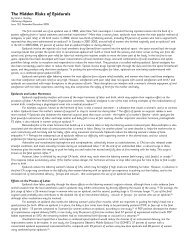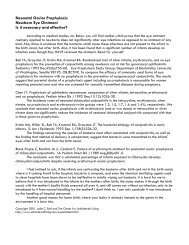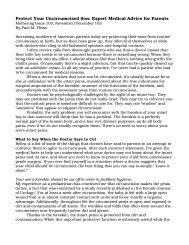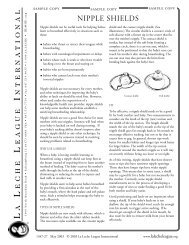Circ Lost List
Circ Lost List
Circ Lost List
Create successful ePaper yourself
Turn your PDF publications into a flip-book with our unique Google optimized e-Paper software.
What Is <strong>Lost</strong> Due to <strong>Circ</strong>umcision<br />
The <strong>Lost</strong> <strong>List</strong><br />
www.norm.org<br />
Thanks to Gary Harryman for putting this together<br />
Many people think circumcision removes nothing more than a little extra skin. The truth is that<br />
circumcision removes several critical components of male sexual anatomy. This list enumerates everything<br />
currently known to be lost when one is circumcised. Included are notes on whether these losses can or<br />
cannot be amended by foreskin restoration.<br />
The information contained in this list may be upsetting to some, but we feel it is important and<br />
necessary for those considering restoration to understand as fully as possible the<br />
anatomy/biology/neurology of what has been removed and/or destroyed.<br />
It should be pointed out that circumcisions performed in North America may be more severe than<br />
those done elsewhere. In the United States, most hospital circumcisions are done to the Bris Periah<br />
standard of removing every ounce of foreskin and, in a large percentage of cases, some shaft skin.<br />
Although several of the items in this list are not restorable, there are many significant gains to be<br />
realized by restoring one's foreskin. For information on these gains, please see the Benefits page.<br />
Please note that although circumcision and foreskin restoration involve issues of physical health<br />
and well-being, nothing appearing on this website is intended to be medical advice. If you want medical<br />
advice or have a medical problem, contact a doctor.<br />
Foreskin - Restorable<br />
The foreskin comprises roughly 50% (and sometimes more) of the mobile skin system of the penis. If<br />
unfolded and spread out flat, the average adult foreskin would measure about 15 square inches - the size<br />
of a three-by-five index card. This highly specialized tissue normally covers the glans and protects it from<br />
abrasion, drying, callusing (also called keratinization), and contaminants of all kinds.<br />
We refer to the process we undergo as foreskin restoration but we don't actually grow new<br />
foreskins. What we do instead is to extend the remaining skin on the shaft of the penis. The non-surgical<br />
techniques we use induce the skin to grow additional cells, and over a period of time the shaft skin will<br />
gradually extend to cover the glans. The extended skin looks and behaves and functions much like a<br />
natural foreskin.<br />
[Sources: 1. M. M. Lander, "The Human Prepuce," in G. C. Denniston and M. F. Milos, eds., Sexual Mutilations: A Human Tragedy (New<br />
York: Plenum Press, 1997), 79-81. 2. M. Davenport, "Problems with the Penis and Prepuce: Natural History of the Foreskin," British<br />
Medical Journal 312 (1996): 299-301.]<br />
Frenar Band or Ridged Band - <strong>Lost</strong><br />
The frenar band is a group of soft ridges near the junction of the inner and outer foreskin. This region is the<br />
primary erogenous zone of the intact male body. Loss of this delicate belt of densely innervated, sexually<br />
responsive tissue reduces the fullness and intensity of sexual response.<br />
There is no known method of restoring the frenar band.<br />
[Source: Taylor, J. R. et al., "The Prepuce: Specialized Mucosa of the Penis and Its Loss to <strong>Circ</strong>umcision," British Journal of Urology 77<br />
(1996): 291-295.]<br />
Gliding Action - Restorable<br />
The foreskin's gliding action is a hallmark feature of the normal, natural, intact penis. This non-abrasive<br />
gliding of the penis in and out of its own shaft skin facilitates smooth, comfortable, pleasurable intercourse<br />
for both partners. Without this gliding action, the corona of the circumcised penis can function as a oneway<br />
valve, making artificial lubricants necessary for comfortable intercourse.<br />
The return of this natural gliding action is one of the primary benefits of foreskin restoration. In many<br />
cases, wives of restoring men were initially doubtful about restoration but came to value it highly when<br />
their husbands had grown enough new skin to effect greater levels of comfort and pleasure during<br />
intercourse.
[Source: P. M. Fleiss, MD, MPH, "The Case Against <strong>Circ</strong>umcision," Mothering: The Magazine of Natural Family Living (Winter 1997): 36-<br />
45.]<br />
Meissner's Corpuscles - <strong>Lost</strong><br />
<strong>Circ</strong>umcision removes the most important sensory component of the foreskin - thousands of coiled finetouch<br />
receptors called Meissner's corpuscles. Also lost are branches of the dorsal nerve, and between<br />
10,000 and 20,000 specialized erotogenic nerve endings of several types. Together these detect subtle<br />
changes in motion and temperature, as well as fine gradations in texture.<br />
There is no known method of restoring Meissner's corpuscles or other specialized sensory nerve<br />
cells. However, restoring and restored men almost universally experience tremendous increases in<br />
sensitivity, in part because the highly sensitive nerve cells in the glans are no longer buried under several<br />
layers of keratinized skin.<br />
[Sources: 1. R. K. Winkelmann, "The Erogenous Zones: Their Nerve Supply and Its Significance," Proceedings of the Staff Meetings of<br />
the Mayo Clinic 34 (1959): 39-47. 2. R. K. Winkelmann, "The Cutaneous Innervation of Human Newborn Prepuce," Journal of<br />
Investigative Dermatology 26 (1956): 53-67.]<br />
Frenulum - <strong>Lost</strong><br />
The frenulum is a highly erogenous V-shaped structure on the underside of the glans that tethers the<br />
foreskin. During circumcision it is frequently either amputated with the foreskin or severed, which destroys<br />
or diminishes its sexual and physiological functions.<br />
If the frenulum is amputated, there is no known method of replacing it. If only a small portion of the<br />
frenulum is left, it is probably no longer functional as a tethering structure. There is no known method of<br />
attaching it to a restored foreskin, but some men have reported stretching the frenulum remnant as they<br />
stretched their foreskin.<br />
[Sources: 1. Cold, C, Taylor, J, "The Prepuce," BJU International 83, Suppl. 1, (1999): 34-44. 2. Kaplan, G.W., "Complications of<br />
<strong>Circ</strong>umcision," Urologic Clinics of North America 10, 1983.]<br />
Dartos Fascia - <strong>Lost</strong><br />
<strong>Circ</strong>umcision removes approximately half of this temperature-sensitive smooth muscle sheath which lies<br />
between the outer layer of skin and the corpus cavernosa.<br />
There is no known method of restoring amputated portions of the dartos fascia. However, the new<br />
skin may duplicate dartos fascia muscle tissue if it is present in the remnant skin that is being stretched.<br />
[Source: Netter, F.H., "Atlas of Human Anatomy," Second Edition (Novartis, 1997): Plates 234, 329, 338, 354, 355.]<br />
Immunological System - <strong>Lost</strong><br />
The soft mucosa (inner foreskin) contains its own immunological defense system which produces plasma<br />
cells. These cells secrete immunoglobulin antibodies as well as antibacterial and antiviral proteins,<br />
including the pathogen killing enzyme lysozyme.<br />
Once removed with the foreskin, there is no known method of restoring this immunological<br />
defense system.<br />
[Sources: 1. A. Ahmed and A. W. Jones, "Apocrine Cystadenoma: A Report of Two Cases Occurring on the Prepuce," British Journal<br />
of Dermatology 81 (1969): 899-901. 2. P. J. Flower et al., "An Immunopathologic Study of the Bovine Prepuce," Veterinary Pathology<br />
20 (1983):189-202.]<br />
Lymphatic Vessels - <strong>Lost</strong><br />
The loss of these vessels due to circumcision reduces the lymph flow within that part of the body's immune<br />
system.<br />
While some lymphatic vessels remain, there is no known method of restoring those that were<br />
removed during circumcision.<br />
[Source: Netter, F.H., "Atlas of Human Anatomy," Second Edition (Novartis, 1997): plate 379.]<br />
Estrogen Receptors - <strong>Lost</strong><br />
The presence of estrogen receptors within the foreskin has only recently been discovered. Their purpose is<br />
not yet understood and needs further study.
There is no known method of restoring the foreskin's estrogen receptors.<br />
[Source: R. Hausmann et al., "The Forensic Value of the Immunohistochemical Detection of Oestrogen Receptors in Vaginal<br />
Epithelium," International Journal of Legal Medicine 109 (1996): 10-30.]<br />
Apocrine Glands - <strong>Lost</strong><br />
These glands of the inner foreskin produce pheromones - nature's powerful, silent, invisible behavioral<br />
signals to potential sexual partners. The effect of their absence on human sexuality has never been<br />
studied.<br />
There is no known method of restoring apocrine glands to the penis.<br />
[Source: A. Ahmed and A. W. Jones, "Apocrine Cystadenoma: A Report of Two Cases Occurring on the Prepuce," British Journal of<br />
Dermatology 81 (1969): 899-901.]<br />
Sebaceous Glands - <strong>Lost</strong><br />
The sebaceous glands may lubricate and moisturize the foreskin and glans, which is normally a protected<br />
internal organ. Not all men have sebaceous glands on their inner foreskin.<br />
There is no known method of restoring sebaceous glands if they were present..<br />
[Source: A. B. Hyman and M. H. Brownstein, "Tyson's Glands: Ectopic Sebaceous Glands and Papillomatosis Penis," Archives of<br />
Dermatology 99 (1969): 31-37.]<br />
Langerhans Cells - <strong>Lost</strong><br />
These specialized epithelial cells are a component of the immune system in the penis.<br />
There is no known method of restoring Langerhans cells to the penis.<br />
[Source: G. N. Weiss et al., "The Distribution and Density of Langerhans Cells in the Human Prepuce: Site of a Diminished Immune<br />
Response" Israel Journal of Medical Sciences 29 (1993): 42-43.]<br />
Natural Glans Coloration - Restorable<br />
The natural coloration of the glans and inner foreskin (usually hidden and only visible to others when<br />
sexually aroused) is considerably more intense than the permanently exposed and keratinized coloration<br />
of a circumcised penis. The socio-biological function of this visual stimulus has never been studied.<br />
The glans ranges from pink to red to dark purple among intact men of Northern European<br />
ancestry, and from pinkish to mahagony to dark brown among intact men of Color. If circumcision is<br />
performed on an infant or young boy, the connective tissue which protectively fuses the foreskin and<br />
glans together is ripped apart. This leaves the glans raw and subject to infection, scarring, pitting,<br />
shrinkage, and eventual discoloration. Over a period of years the glans becomes keratinized, adding<br />
additional layers of tissue in order to adequately protect itself, which further contributes to discoloration.<br />
Many restoring men report dramatic changes in glans color and appearance, and that these<br />
changes closely mirror the natural coloration and smooth, glossy appearance of the glans seen in intact<br />
men.<br />
[Source: P. M. Fleiss, MD, MPH, "The Case Against <strong>Circ</strong>umcision," Mothering: The Magazine of Natural Family Living (Winter 1997): 36-<br />
45.]<br />
Length and <strong>Circ</strong>umference - Restorable<br />
<strong>Circ</strong>umcision removes some of the length and girth of the penis - its double-layered wrapping of loose<br />
and usually overhanging foreskin is removed. A circumcised penis is truncated and thinner than it would<br />
have been if left intact.<br />
Many men have kept detailed records of their measurements before, during, and after<br />
restoration. There is an increasing consensus that foreskin restoration enhances penile length and<br />
circumference.<br />
[Source: R. D. Talarico and J. E. Jasaitis, "Concealed Penis: A Complication of Neonatal <strong>Circ</strong>umcision," Journal of Urology 110 (1973):<br />
732-733.]
Blood Vessels - <strong>Lost</strong><br />
Several feet of blood vessels, including the frenular artery and branches of the dorsal artery, are removed<br />
in circumcision. The loss of this rich vascularization interrupts normal blood flow to the shaft and glans of<br />
the penis, damaging the natural function of the penis and altering its development.<br />
There is no known method of restoring arteries and vessels that were removed during circumcision.<br />
However, many restoring men have noticed that the new skin is more richly vascularized than the older<br />
skin of their penis. We have no medical explanation for this phenomenon.<br />
[Sources: 1. H. C. Bazett et al., "Depth, Distribution and Probable Identification in the Prepuce of Sensory End-Organs Concerned in<br />
Sensations of Temperature and Touch; Thermometric Conductivity," Archives of Neurology and Psychiatry 27 (1932): 489-517. 2.<br />
Netter, F.H., "Atlas of Human Anatomy," Second Edition (Novartis, 1997): plates 238, 239.]<br />
Dorsal Nerves - <strong>Lost</strong><br />
The terminal branch of the pudendal nerve connects to the skin of the penis, the prepuce, the corpora<br />
cavernosa, and the glans. Destruction of these nerves is a rare but devastating complication of<br />
circumcision. If cut during circumcision, the top two-thirds of the penis will be almost completely without<br />
sensation.<br />
There is no known method of restoring dorsal nerves.<br />
[Sources: 1. Agur, A.M.R. ed., "Grant's Atlas of Anatomy," Ninth Edition (Williams and Wilkins, 1991): 188-190. 2. Netter, F.H., "Atlas of<br />
Human Anatomy," Second Edition (Novartis, 1997): plate 380, 387.]<br />
Other Losses<br />
• <strong>Circ</strong>umcision performed during infancy disrupts the bonding process between child and mother. There<br />
are indications that the innate sense of trust in intimate human contact is inhibited or lost. It can also have<br />
significant adverse effects on neurological development. Additionally, an infant's self-confidence and<br />
hardiness is diminished by forcing the newborn victim into a defensive psychological state of "learned<br />
helplessness" or "acquired passivity" to cope with the excruciating pain which he can neither fight nor flee.<br />
The trauma of this early pain lowers a circumcised boy's pain threshold below that of intact boys and girls<br />
[Sources: 1. R. Goldman, <strong>Circ</strong>umcision: The Hidden Trauma (Boston: Vanguard Publications, 1997), 139-175. 2. A. Taddio et al.,<br />
"Effect of Neonatal <strong>Circ</strong>umcision on Pain Responses during Vaccination in Boys," Lancet 345 (1995): 291-292.]<br />
• Every year some boys lose their entire penises from circumcision accidents and infections. They are then<br />
"sexually reassigned" by castration and transgender surgery, and are expected to live their lives as<br />
females.<br />
[Sources: 1. J. P. Gearhart and J. A. Rock, "Total Ablation of the Penis after <strong>Circ</strong>umcision with Electrocautery: A Method of<br />
Management and Long-Term Followup," Journal of Urology 142 (1989):799-801. 2. M. Diamond and H. K. Sigmundson, "Sex<br />
Reassignment at Birth: Long-Term Review and Clinical Implications," Archives of Pediatrics and Adolescent Medicine 151 (1997): 298-<br />
304.]<br />
• Every year many boys in the United States and elsewhere lose their lives as a result of circumcision - a<br />
fact that is routinely ignored or obscured.<br />
[Sources: 1. G. W. Kaplan, "Complications of <strong>Circ</strong>umcision," Urologic Clinics of North America 10 (1983): 543-549. 2. R. S. Thompson,<br />
"Routine <strong>Circ</strong>umcision in the Newborn: An Opposing View," Journal of Family Practice 31 (1990): 189-196.
The Fox who had <strong>Lost</strong> his Tail<br />
A FOX, caught in a trap, escaped by tearing off his brushy tail.<br />
After that, the other animals mocked him, making him feel so ashamed that his life was a burden<br />
to him. He therefore worked out a plan to make all the other foxes the same as him, so that in their<br />
common loss he might better conceal his own deprivation.<br />
He called a meeting of foxes. A good many came to it, and he gave a speech, advising them all<br />
to cut off their tails. He said that they would not only look much better without them, but that they would<br />
get rid of the weight of the brush, which was a very great inconvenience.<br />
But one of them interrupted his speech.<br />
If you had not lost your own tail, my friend, that fox said, "you would not be giving us this advice."<br />
- Æsop, 6th century BCE











